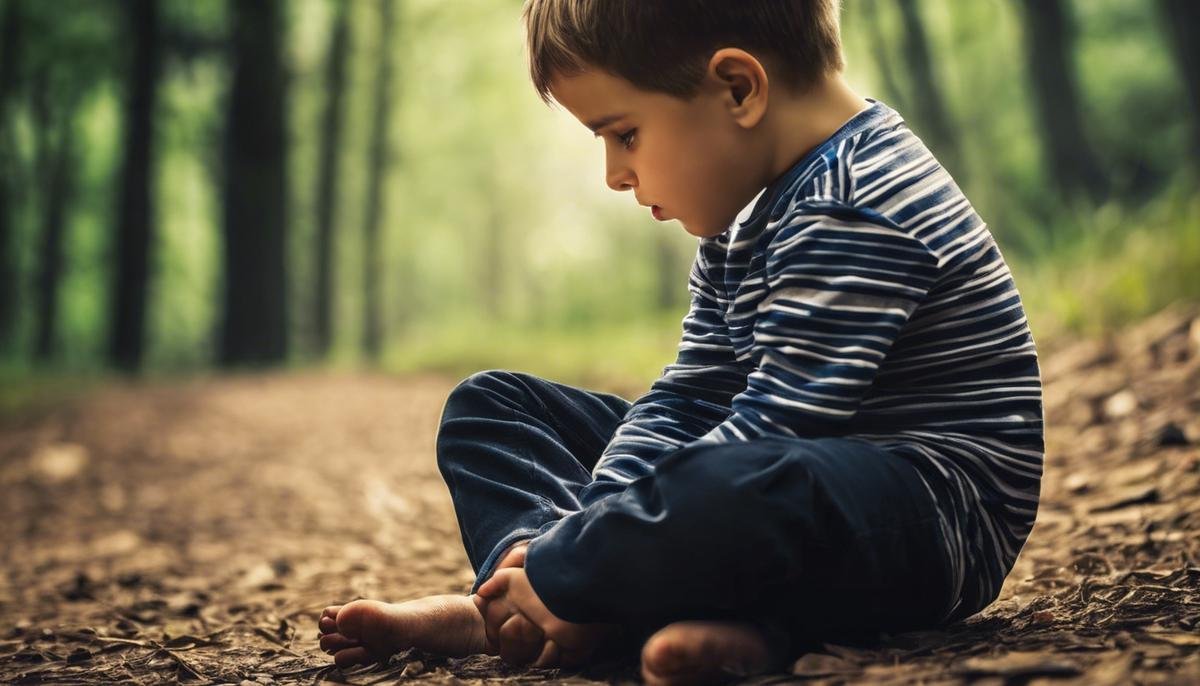
Autism, a complex neurological and developmental condition, often manifests in a varied range of behaviors; aggression being notable among them. Despite its widespread prevalence, understanding and managing aggression in autistic children remains a profound challenge — primarily due to underlying misconceptions and its multifaceted nature. Without appropriate information and empathy, managing such behavior may seem daunting, leading to further complications in the life of the child and their families.
To effectively navigate this challenging landscape, it becomes crucial to delve deeper into the realms of autism and associated aggressive behaviors. By exploring the nuances of this behavior, individual triggers, and early warning signs, we can enhance our understanding and develop effective coping strategies. Let’s embark on this enlightening journey, aided by practical knowledge, widespread empathy, and love.
Understanding Autism and Aggression
Unraveling the Link Between Autism and Aggressive Behavior
As parents, we all want the best for our children. We crave their happiness, yearn for their success, and above all else, desire their well-being. So when it’s time to decode the sometimes complex realm of behavioral disorders like autism, it can seem nothing short of overwhelming. But knowledge truly is power, and understanding the relationship between autism and aggressive behavior can enlighten our perceptions, strengthen our parenting skills, and most importantly, enhance the love and support we afford our little ones.
Autism, also known as Autism Spectrum Disorder, is a neurological and developmental disorder. It impacts essential human abilities such as social interaction, communication, and cognitive function. Often, one of the outcomes of this influence is the manifestation of aggressive behaviors – a relationship that can sometimes feel puzzling to reconcile.
Aggressive behaviors in autistic children aren’t inexplicable bouts of anger or frustration. Instead, they usually emerge as their unique communication style. Owing to their neurological differences, autistic children occasionally struggle to express their needs, wants, or discomforts verbally. This inability to communicate can potentially escalate into frustration, subsequently leading to aggressive behaviors which acts as their non-verbal language.
Furthermore, autistic children often have a profound need for routines and predictability. They might become distressed when their routine shifts or when confronted with an unfamiliar situation. Acts of aggression can seem like an instinctual response from them trying to restore their world’s order and familiarity.
On the other hand, sensory overload – too much noise, light, or human interaction – can also stimulate aggressive behaviors. Many autistic individuals possess heightened sensitivity to sensory stimuli. This overload can often prove overwhelming, causing them to react aggressively in an attempt to defend themselves from the perceived sensory assault.
However, it’s crucial to remember that not all autistic individuals exhibit aggression. Each child is a universe unto themselves, resplendent with a unique blend of gifts, challenges, and personality traits. Addressing aggressive behavior in children with autism isn’t about curbing their natural temperament or forcing conformity. Rather, it’s about providing them with the tools and strategies they need to express themselves without resorting to aggression.
It’s about teaching them alternative, healthier ways of communicating their needs and emotions, and being there to support them in their journey – reminding them, and ourselves, that we are all works in progress.
Working with professionals, such as behavioral therapists, can prove to be of significant help in this aspect. By employing behavioral modification techniques and offering targeted support, they can guide a child toward less aggressive means of communication. Patience, understanding, and love reinforce these strategies and deepen the bond between parent and child.
Ultimately, the relationship between autism and aggressive behavior is a call for increased understanding and communication. As parents, we can transform moments of aggressive behavior into opportunities for growth – for both our children and ourselves. After all, if parenting has taught us one thing, it’s that the journey is never complete, but it’s a journey we would not trade for anything else. Our children, in all their uniqueness, are the real essence of our lives and their successes, no matter how small, provide us with unmatched joy.
So, here’s to understanding, to growing, and to the bountiful love beyond all the challenges – that encapsulates the beautiful journey of parenthood.

Common Triggers of Aggression in Autistic Children
Demystifying Aggression in Autism: Uncovering Underlying Triggers
Having highlighted the connection between autism and aggressive behaviors, as well as the unique communication style these children often adopt, let’s delve deeper. Autistic children’s aggression can often be tied to specific triggers. It’s essential to remember that understanding and recognizing these triggers can significantly help manage these behaviors at home.
- Frustration Due To Communication Difficulties
- Environmental Changes
- Difficulty Dealing with Emotions
- Underestimating Cognitive Load
One primary trigger of aggressive behavior in autistic children could be attributed to communication difficulties. Imagine not being able to express your feelings adequately – infuriating, isn’t it? For some autistic children, the challenge of expressing their needs, wants, or pain can lead to feelings of frustration, resulting in aggressive behaviors.
Autism often results in individuals craving predictability and routines. However, the world isn’t always predictable. Any disruption to the regular daily routine – such as an impromptu visit to a new location or a rushed morning – can lead to increased anxiety. This anxiety could manifest as aggression or tantrums.
Emotions can be a confusing whirlwind for most people, and more so for autistic individuals. Difficulty in identifying, expressing, or managing feelings can also be a trigger for aggressive behaviors. Seemingly small negatives like losing a game can bring out a big reaction due to this emotional disarray.
Tasks that may seem simple to us can be overwhelming to autistic children. Multi-step instructions or immersive learning modules can give rise to what we call a ‘cognitive overload.’ When cognitive load is too high, children may exhibit aggressive behaviors as a form of escape.
Significantly, the role of teaching alternative and healthier communication forms cannot be overstated. Building a strong language base comes in very handy; for instance, teaching children to use phrases like “I need help” or “I am upset” can go a long way in mitigating aggressive behaviors.
Remember, behavioral therapists can play a pivotal role in this journey as well. They can help children with autism develop a better understanding of emotions and how to handle them. Plus, they can assist in curating individualized strategies to manage potential triggers of aggressive behavior.
Throughout all this, it is vital to uphold patience, open communication, and understanding. Like every child, children with autism continue to learn, grow and evolve. While this journey is paved with trials, it also presents unique joys and milestones that make the challenging times worthwhile.
Essentially, whether you’re a first-time parent or a seasoned veteran, living with and caring for a child with autism can be a voyage of discovery. It teaches us resilience, empathy, and unconditional love. We must continue spreading awareness about autism, extend our support to parents worldwide, and celebrate the distinct individuality of every child with autism.

Detecting Early Signs of Aggression
While the journey of parenting can often feel like venturing into the unknown, it can be especially challenging for those parents who have children on the autism spectrum. By building a realm of understanding around the early signs of aggressive behavior in autistic children, we can help to defuse any angst, foster better communication, and support in creating a nurturing and inclusive environment for children with autism.
As we shift our focus to early signs of aggressive behavior, we begin to realize that disruptive behaviors often stem from frustration. While it’s easy to understand an upset child when they’re able to use their words, for an autistic child, putting feelings into words can sometimes be like trying to catch a whirlwind with a butterfly net. Aggression may be their only way to signal distress, hurt, or need.
Watching for hints such as a sudden shift in demeanor, or increased self-stimulating behaviors (stimming), can be useful indicators of brewing frustration. Additionally, autistic children may display physical signs like clenching fists, pacing, yelling, or obsessively repeating certain actions, all of which could be signs of oncoming aggression.
When confronted with environmental changes, many children with autism struggle to adapt. Changes in schedule, surroundings, or even minor disruptions like an unexpected visitor could potentially trigger aggressive behavior. As hard as it is, being proactive and preparing your child for inevitable changes, no matter how small they may seem, can dramatically help curb their frustration and anxiety levels.
Like anyone else, autistic children experience a wide range of emotions. What changes, however, is their difficulty in processing and appropriately expressing these emotions. This challenge can wreak havoc on their emotional equilibrium, often intensifying feelings of frustration and triggering aggressive reactions.
Just as a computer slows down when overloaded with data, an autistic child’s brain can struggle under the cognitive load of processing simultaneous information. Tasks that seem easy to us, like listening to instructions while tying a shoe, could stress and frustrate autistic children. Learning to break down tasks into smaller, feasible steps can give them much-needed breathing space.
Turning the tables from aggression to constructive communication isn’t as daunting as one might perceive. Simple tools such as visual guide cards or specialized communication apps can improve your child’s ability to express themselves better.
Enlisting professional help, like behavioral therapists, doesn’t mean you’re falling short as a parent. It’s accepting that even parents need a little guiding flare amidst the obscurity of unanswered questions. They can provide behavior maps and specific strategies tailored to your child’s unique needs.
As parents, embracing empathy, open communication, and understanding is our greatest tool in promoting healthier relationships with our autistic children. And while they may not always comprehend the world as we do, they are teaching us resilience, love in its rawest form, and most importantly – patience; transforming us not only into better parents but better humans overall.
Every child, autistic or not, is their own special star in the galaxy of life. And such a voyage of discovery that we as parents get to undertake! One that’s filled with unimaginable learning and rewarding milestones. The key is to light the path of understanding, awareness, and support for autism, and watch as magical transformations unfold. After all, in this space of parenting, we’re not just raising children – we’re raising bright, shiny futures!

Coping Strategies and Solutions
Continuing the Journey: Helpful Strategies for Managing Aggression in Children with Autism
Sure, navigating the needs of an autistic child might be daunting but providing a safe and supportive environment can create a big difference. After an understanding of autism and its unique characteristics, the next step is working towards effective methods to manage aggression in autistic children.
While we’ve previously discussed the role of frustration and difficulties communicating as potential triggers for aggressive behavior, let’s delve deeper. Teachable moments often exist amid struggles, so let’s consider some strategies to better manage and aid this journey.
Being proactive makes a lot of sense in these situations. One step could involve breaking down large, potentially overwhelming tasks, into smaller, manageable steps. Each tiny victory can bolster self-confidence in these children and drastically reduce the chance of frustration-induced aggressive behavior. Think of it as easier digestion of information, facilitating better functioning in the long run.
Similarly, environmental changes can often act as catalysts to aggression. But maintaining a predictable, consistent environment may help keep them calm and composed. Scheduled activities, familiar settings, and even their favorite toys can all contribute to providing a sense of calm and reducing anxiety.
Problems expressing emotions could also lead to aggressive behaviors. Various tools such as visual guide cards and communication apps may help autistic children process emotions better and express them more healthfully. These tools foster a sense of control in their communication, which may reduce angst and consequent aggressive behavior.
Seeking professional help could also be significantly beneficial. Experienced therapists can provide personalized behavior maps and monitor progress closely. Keep in mind, every child is extraordinary, and the more tailored the approach, the better the results can be.
Let’s not forget – this isn’t just about managing aggressive behavior but also about fostering growth for the child, and growth comes from understanding. Parents play an enormous part in this journey, showing empathy, consistently communicating, and above all, being understanding. Upholding patience could incredibly orientate the journey on a more positive path.
Resilience and love have transformative power. Parenting autistic children can be a demanding journey. Still, it can also bring unparalleled joys, indescribable milestones, and a level of enduring bond seen seldom elsewhere.
Finally, let’s remember the importance of spreading awareness about autism. The more the awareness, the higher the understanding, not just within the family but also the community. Support is crucial, not just for the child but also for the parents pedaling their journey of discovery and learning.
Managing aggressive behaviors in children with autism need not be an uphill struggle. With understanding, patience, guidance, and a loving environment, this parenting journey can indeed become the voyage of a lifetime.

Aggression is a common challenge faced by children on the autism spectrum. However, this doesn’t imply that managing it is out of our hands. By identifying common triggers, observing early signs, and formulating effective coping mechanisms, we can create a supportive, safe, and nurturing environment for our children to thrive in. The journey towards understanding and alleviating aggressive behavior in autistic children is steeped in patience, love, understanding, and constant learning.
With the right knowledge, insights, and professional help, we can ensure that our guidance helps them confront their everyday challenges better. Let’s remember, every child is unique, and so is their experience with autism. The mosaic of autism is multi-faceted, colored by different symptoms and triggers, and our approach should be providing each child with the right support they need to flourish.





